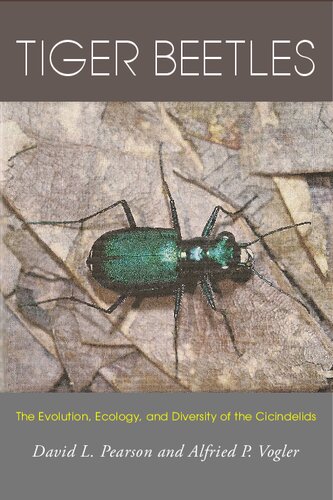

Most ebook files are in PDF format, so you can easily read them using various software such as Foxit Reader or directly on the Google Chrome browser.
Some ebook files are released by publishers in other formats such as .awz, .mobi, .epub, .fb2, etc. You may need to install specific software to read these formats on mobile/PC, such as Calibre.
Please read the tutorial at this link. https://ebooknice.com/page/post?id=faq
We offer FREE conversion to the popular formats you request; however, this may take some time. Therefore, right after payment, please email us, and we will try to provide the service as quickly as possible.
For some exceptional file formats or broken links (if any), please refrain from opening any disputes. Instead, email us first, and we will try to assist within a maximum of 6 hours.
EbookNice Team

Status:
Available4.4
27 reviews(Ebook) Tiger beetles The evolution ecology and diversity of the Cicindelids 1st Edition by David L Pearson, Alfried P Vogler - Ebook PDF Instant Download/Delivery: 9780801438820 ,0801438829
Full download (Ebook) Tiger beetles The evolution ecology and diversity of the Cicindelids 1st Edition after payment

Product details:
ISBN 10: 0801438829
ISBN 13: 9780801438820
Author: David L Pearson, Alfried P Vogler
(Ebook) Tiger beetles The evolution ecology and diversity of the Cicindelids 1st Edition Table of contents:
Why Study Tiger Beetles?
On Whose Shoulders Are We Standing?
How Valuable Are Tiger Beetles for Scientific Studies?
What Is Unique about Tiger Beetles?
Life Cycle Stages
The Classification of Cicindelidae
The Evolution of Diversity
What Is a Species?
Why Do We Care about Species?
Chromosomes and Sex Cells
Chromosome Evolution and Speciation
Biogeography
Why Are There More Species in Some Places Than in Others?
Where Did Tiger Beetles Come from and How Did They Get There?
Surviving the Elements
Tiger Beetles in Their Physical Habitats
Maintaining a Constant Internal Environment
Responding to Longer Term Environmental Changes
Evolutionary Ramifications
Finding and Courting Mates
Sexual Selection and the Logic of Female Choice
Mating and Reproduction
Escaping and Avoiding Enemies
Who Is the Enemy?
Antipredator Characters
Multiple Antipredator Defenses
Defense Chemicals — Local Adaptation or Historical Coincidence?
Coping with Competitors
Food and Foraging Behavior
How Do Tiger Beetles Confront Competition?
Are There Patterns of Species Co-occurrence within a Community?
The Species Radiation of Tiger Beetles: What Promotes Diversification?
Economics and Conservation
Economic Use
Conservation
Cross-Taxon Comparisons and the Problem of Statistical Autocorrelations
Molecular Studies and Conservation
Future Studies and Synthesis
Studying Distributional Patterns
The Need for Studying Subspecies
Global Comparisons
Updating Reconstructed Phylogenies and the Impact on Their Predictive Powers
Chaetotaxy and Integrative Biology
Conclusions
Appendix A. Observing and Collecting Tiger Beetles
Appendix B. Natural History of the Major Tiger Beetle Genera of the World
Literature Cited
Taxonomic Index
Subject Index
People also search for (Ebook) Tiger beetles The evolution ecology and diversity of the Cicindelids 1st Edition:
are tiger beetles endangered
green tiger beetles
the evolution and genomic basis of beetle diversity
how do beetles display genetic diversity
keystone species tiger
Tags: David L Pearson, Alfried P Vogler, Tiger beetles, evolution, ecology, Cicindelids